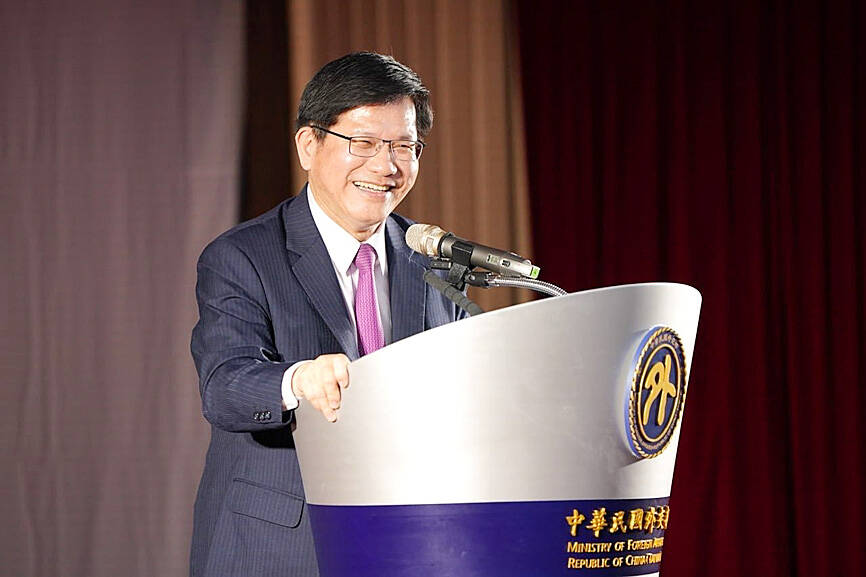Minister of Foreign Affairs Lin Chia-lung (林佳龍) and National Security Council Secretary-General Joseph Wu (吳釗燮) were in the US this week for closed-door meetings with US officials, the Financial Times reported on Thursday.
Wu and Lin were in the Washington area for talks through a format called the “special channel,” the newspaper cited unnamed sources as saying.
Although the “special channel” was first disclosed by the Financial Times in 2021 when Wu met his US counterpart, senior officials from Taiwan and the US have used the mechanism for years to hold talks, it said.

Photo courtesy of the Ministry of Foreign Affairs
The US government has kept the channel secret to avoid butting heads with Beijing, known for strenuously protesting any sign of diplomatic engagement between Taiwan and other states, it said.
Wu and then-council secretary-general Wellington Koo (顧立雄) met with US officials during the previous “special channel” in February last year, it said.
The security dialogue is usually conducted in the area surrounding Washington, as long-standing practice prevents the nation’s foreign and defense ministers from entering the capital, it said.
Sources did not disclose the location or timing of the talks, the Financial Times said in its report.
The Taipei Economic and Cultural Representative Office declined the paper’s request for comments, as did the White House.
The special channel is “one of the most sensitive and important mechanisms in global politics today,” Evan Medeiros, a senior fellow at Georgetown University’s Initiative for US-China Dialogue on Global Issues, was quoted as saying.
“The meeting comes at a critical time given Taiwan’s recent election. Clear and consistent communication between Taipei and Washington is essential, especially as People’s Republic of China pressure grows,” Medeiros said.
The “special channel” was important due to limits on contact allowed by the unofficial relationship between Taiwan and the US, the newspaper cited Project 2049 Institute chairman Randall Schriver as saying.
“A lot of people have the impression that [Chinese People’s Liberation Army] military activity spikes around events like the [former US House of Representatives speaker Nancy] Pelosi visit or [presidential] inaugurations, and then enters a normal and steady status quo, but the PLA continues to do more things and evolve. We are seeing more nighttime exercises and things like air-to-air refueling on the eastern side of Taiwan,” Schriver was quoted as saying.

SHIPS, TRAINS AND AUTOMOBILES: The ministry has announced changes to varied transportation industries taking effect soon, with a number of effects for passengers Beginning next month, the post office is canceling signature upon delivery and written inquiry services for international registered small packets in accordance with the new policy of the Universal Postal Union, the Ministry of Transportation and Communications said yesterday. The new policy does not apply to packets that are to be delivered to China, the ministry said. Senders of international registered small packets would receive a NT$10 rebate on postage if the packets are sent from Jan. 1 to March 31, it added. The ministry said that three other policies are also scheduled to take effect next month. International cruise ship operators

HORROR STORIES: One victim recounted not realizing they had been stabbed and seeing people bleeding, while another recalled breaking down in tears after fleeing A man on Friday died after he tried to fight the knife-wielding suspect who went on a stabbing spree near two of Taipei’s busiest metro stations, Taipei Mayor Chiang Wan-an (蔣萬安) said. The 57-year-old man, identified by his family name, Yu (余), encountered the suspect at Exit M7 of Taipei Main Station and immediately tried to stop him, but was fatally wounded and later died, Chiang said, calling the incident “heartbreaking.” Yu’s family would receive at least NT$5 million (US$158,584) in compensation through the Taipei Rapid Transit Corp’s (TRTC) insurance coverage, he said after convening an emergency security response meeting yesterday morning. National

PLANNED: The suspect visited the crime scene before the killings, seeking information on how to access the roof, and had extensively researched a 2014 stabbing incident The suspect in a stabbing attack that killed three people and injured 11 in Taipei on Friday had planned the assault and set fires at other locations earlier in the day, law enforcement officials said yesterday. National Police Agency (NPA) Director-General Chang Jung-hsin (張榮興) said the suspect, a 27-year-old man named Chang Wen (張文), began the attacks at 3:40pm, first setting off smoke bombs on a road, damaging cars and motorbikes. Earlier, Chang Wen set fire to a rental room where he was staying on Gongyuan Road in Zhongzheng District (中正), Chang Jung-hsin said. The suspect later threw smoke grenades near two exits

The Forestry and Nature Conservation Agency yesterday launched a gift box to market honey “certified by a Formosan black bear” in appreciation of a beekeeper’s amicable interaction with a honey-thieving bear. Beekeeper Chih Ming-chen (池明鎮) in January inspected his bee farm in Hualien County’s Jhuosi Township (卓溪) and found that more than 20 beehives had been destroyed and many hives were eaten, with bear droppings and paw prints near the destroyed hives, the agency said. Chih returned to the farm to move the remaining beehives away that evening when he encountered a Formosan black bear only 20m away, the agency said. The bear